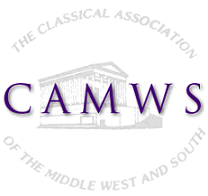Welcome to Teaching Classical Languages (TCL). TCL is the peer-reviewed, online journal dedicated to exploring how we teach (and how we learn) Greek and Latin. TCL is sponsored by the Classical Association of the Middle West and South (CAMWS).
Volume 11, Issue 1

Abstracts of Articles
Implementing IPAs: One Department’s Odyssey
Integrated Performance Assessments (IPAs) allow students to show what they know via the three modes of communication: Interpretive, Interpersonal, and Presentational. This is an account of one foreign language department’s multi-year journey in refining its assessments and transitioning to the use of IPAs throughout the year, including in lieu of final exams. This paper will provide an account of the work that one foreign language department has been doing in recent years to improve the way students are assessed by adopting IPAs, with specific examples provided from Latin classes. Examples given will focus primarily on Interpretive Reading, Interpersonal Writing, and Presentational Writing. This paper addresses the reasoning behind choosing IPAs, detailed information about what they are, and the results the department has had so far. Lastly, this paper discusses how the department has changed the way classes are taught and assessed, with specific attention given to the Latin classroom.
Visualizing Vocabulary: Student-Driven Visual Vocabularies
This article explores the use of visual vocabularies created by students on Padlet as a tool for enhancing students’ engagement with Greek and Latin vocabulary. Given that vocabulary may be undervalued by instructors in favor of more complicated grammatical concepts, this article claims the necessary focus that instructors should put on vocabulary exercises. Informed by research in cognitive psychology on dual coding (i.e., encoding information in memory both visually and lexically), this article also argues that instructors can enhance student retention of Greek and Latin vocabulary through the use of visually rich, student-driven visual vocabularies. By providing students with vocabulary lists of frequently used Greek or Latin words and asking students to find images that illustrate the meaning of those words, instructors enliven the learning process for students, helping students to make meaningful connections with these words in the target language. Using visual vocabularies, instructors help students move towards a greater level of language fluency, processing lexical entries more in terms of concepts and images.
Why Learn Latin? Motivation for Learning a Classical Language
Few studies have examined why people learn classical languages, and none have grounded learners’ reasons within theories of motivation for language learning. We conducted interviews with 12 advanced Latin learners and teachers to investigate why they chose to learn this classical language. A thematic analysis of the interview transcripts revealed nine themes. Some themes were consistent with Self-Determination Theory, including “intrinsic interest” (intrinsic motivation), “sense of prestige” (introjected regulation), and “program requirements” (external regulation), whereas other themes paralleled aspects of Gardner’s Socio-Educational Model (SEM; e.g., “transferable language benefits” is consistent with the instrumental orientation). Some themes posited by extant motivational models were not evident in the transcripts, or necessitated a reinterpretation of extant constructs (e.g., the SEM’s integrative orientation). Other themes that have not been addressed in modern language models pertain specifically to the learning of classical languages like Latin. For example, some participants suggested that learning Latin instills a disciplined or “methodical approach to learning,” particularly for people with certain personality characteristics. The results of this study are discussed in terms of contemporary theories’ capacity to describe motivation to learn classical languages and the implications of the findings for language pedagogy.
The Thomas Project: Evaluating a Web-Based Latin Research Project for Learners at Multiple Levels
This article describes the author’s experience in fashioning a research experience for undergraduate Latin students and in evaluating the success of the project in its early stages. The author developed an on-line translation and commentary project for her students, using a medieval encyclopedia, Thomas Cantimpratensis’s Liber de natura rerum. After addressing the challenges of finding a text and creating the assignment, the article shows how reflecting on such a project can lead to concrete improvements in the student experience. The article outlines the areas of evaluation of the project—rubric, assignment, and student engagement—and summarizes the results of the evaluation to date.

